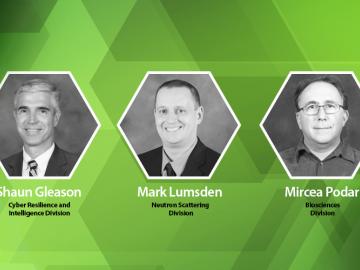
Filter News
Area of Research
- (-) Fusion Energy (2)
- (-) National Security (38)
- (-) Supercomputing (67)
- Advanced Manufacturing (22)
- Biological Systems (1)
- Biology and Environment (43)
- Building Technologies (1)
- Computational Biology (2)
- Computational Engineering (2)
- Computer Science (8)
- Electricity and Smart Grid (3)
- Energy Science (180)
- Energy Sciences (1)
- Functional Materials for Energy (2)
- Fusion and Fission (12)
- Isotope Development and Production (1)
- Isotopes (29)
- Materials (151)
- Materials Characterization (1)
- Materials for Computing (20)
- Materials Under Extremes (1)
- Neutron Science (59)
- Nuclear Science and Technology (15)
- Quantum information Science (2)
- Sensors and Controls (1)
- Transportation Systems (1)
News Topics
- (-) 3-D Printing/Advanced Manufacturing (8)
- (-) Biomedical (17)
- (-) Cybersecurity (23)
- (-) Energy Storage (9)
- (-) Grid (11)
- (-) Isotopes (2)
- (-) Machine Learning (24)
- (-) Materials Science (19)
- (-) Physics (9)
- (-) Polymers (2)
- (-) Space Exploration (3)
- Advanced Reactors (9)
- Artificial Intelligence (46)
- Big Data (25)
- Bioenergy (11)
- Biology (14)
- Biotechnology (3)
- Buildings (4)
- Chemical Sciences (5)
- Computer Science (106)
- Coronavirus (16)
- Critical Materials (3)
- Environment (26)
- Exascale Computing (26)
- Frontier (32)
- Fusion (16)
- High-Performance Computing (45)
- Materials (17)
- Mathematics (2)
- Microscopy (7)
- Molten Salt (1)
- Nanotechnology (11)
- National Security (36)
- Neutron Science (15)
- Nuclear Energy (18)
- Partnerships (5)
- Quantum Computing (20)
- Quantum Science (26)
- Security (15)
- Simulation (16)
- Software (1)
- Summit (43)
- Transportation (8)
Media Contacts

University of Pennsylvania researchers called on computational systems biology expertise at Oak Ridge National Laboratory to analyze large datasets of single-cell RNA sequencing from skin samples afflicted with atopic dermatitis.

A study led by researchers at ORNL used the nation’s fastest supercomputer to close in on the answer to a central question of modern physics that could help conduct development of the next generation of energy technologies.

More than 50 current employees and recent retirees from ORNL received Department of Energy Secretary’s Honor Awards from Secretary Jennifer Granholm in January as part of project teams spanning the national laboratory system. The annual awards recognized 21 teams and three individuals for service and contributions to DOE’s mission and to the benefit of the nation.

Three ORNL scientists have been elected fellows of the American Association for the Advancement of Science, or AAAS, the world’s largest general scientific society and publisher of the Science family of journals.

To explore the inner workings of severe acute respiratory syndrome coronavirus 2, or SARS-CoV-2, researchers from ORNL developed a novel technique.

A team of scientists led by the Department of Energy’s Oak Ridge National Laboratory and the Georgia Institute of Technology is using supercomputing and revolutionary deep learning tools to predict the structures and roles of thousands of proteins with unknown functions.

Neuromorphic devices — which emulate the decision-making processes of the human brain — show great promise for solving pressing scientific problems, but building physical systems to realize this potential presents researchers with a significant

A world-leading researcher in solid electrolytes and sophisticated electron microscopy methods received Oak Ridge National Laboratory’s top science honor today for her work in developing new materials for batteries. The announcement was made during a livestreamed Director’s Awards event hosted by ORNL Director Thomas Zacharia.

A team of collaborators from ORNL, Google Inc., Snowflake Inc. and Ververica GmbH has tested a computing concept that could help speed up real-time processing of data that stream on mobile and other electronic devices.

A team led by the U.S. Department of Energy’s Oak Ridge National Laboratory demonstrated the viability of a “quantum entanglement witness” capable of proving the presence of entanglement between magnetic particles, or spins, in a quantum material.


